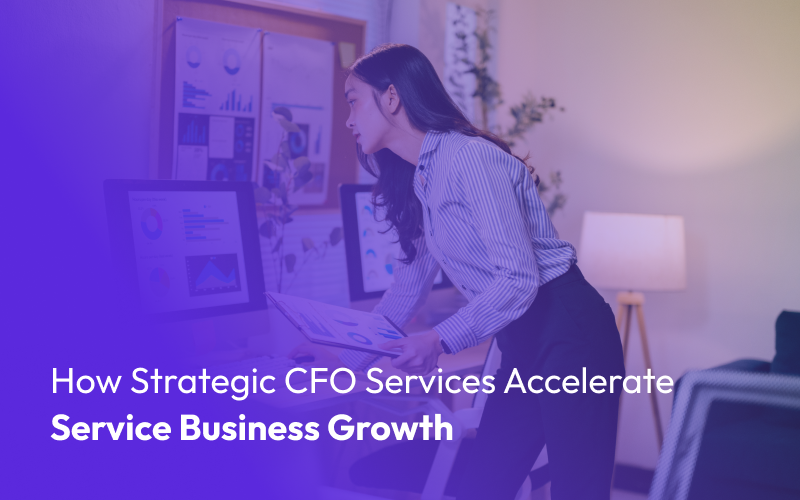You’re running a $5M service business and someone just asked if you want to hit $10M in the next 18 months. The honest answer is probably “yes, but I have no idea if that’s actually possible with my current cash, team, and margins.”
That gap between ambition and financial clarity is exactly where strategic CFO services create their value. This article breaks down what strategic CFOs actually do for scaling service businesses, how they accelerate growth faster than cost-cutting ever could, and what to expect in your first 90 days working with one.
What Strategic CFO Services Mean for Service Businesses
Strategic CFO services involve financial leadership that goes beyond traditional accounting by focusing on long-term planning, operational efficiency, and risk management to support growth. While your typical accountant records what happened last month, a strategic CFO maps out where you’re headed—forecasting cash requirements, modeling hiring decisions, and pinpointing the exact bottleneck preventing you from scaling from $5M to $10M in revenue.
Think of your business like a ship. Your CEO is the captain who sets the destination, your COO manages the crew and daily operations, and your strategic CFO acts as the navigator. The CFO takes your growth target, analyzes your cash position, charts the financial course around obstacles like cash crunches or margin compression, and reports back monthly on whether you’re on track or drifting off course.
Most strategic CFO services come in fractional or outsourced arrangements. This gives service businesses access to executive-level financial expertise without committing to a $200K+ full-time salary.
Why a Strategic CFO Accelerates Growth Faster Than Cutting Costs
Service businesses often assume profitability comes from trimming expenses—smaller office, fewer subscriptions, leaner teams. A strategic CFO flips that assumption entirely. Instead of cost-cutting, they focus on revenue acceleration, margin protection, and strategic reinvestment.
Here’s why this matters: cutting $50K in expenses saves you exactly $50K. But restructuring your pricing model or improving how efficiently your team works can generate $200K in additional profit from the same people. Strategic CFOs identify which financial levers actually move revenue, then help you pull them in the right sequence.
1. Pricing and Packaging Strategy
A strategic CFO digs into profitability across your service lines, clients, and project types to reveal which offerings generate the highest margins. They restructure how you price—shifting from hourly billing to value-based packages, for example—to capture more revenue per engagement without increasing what it costs you to deliver.
See our Pricing Strategy Guide for a detailed breakdown of small business pricing models.
2. Utilization and Capacity Forecasting
Knowing when to hire your next three team members prevents both revenue bottlenecks and cash disasters. A strategic CFO models utilization rates (how much of your team’s time goes to billable work) against your sales pipeline, showing exactly when current capacity maxes out and how much financial runway you have to onboard and train new staff before revenue suffers.
3. Cash Conversion Cycle Improvements
The faster you convert completed work into collected cash, the more fuel you have for growth. Strategic CFOs tighten invoicing schedules, renegotiate payment terms with clients, and implement systems that reduce the gap between project completion and money in your bank account—often shortening this cycle by 15–30 days.
Learn more in our Cash Flow Forecast Guide.
4. Margin Protection on Retainers and Projects
Scope creep quietly destroys profitability in service businesses. A strategic CFO implements tracking systems that flag when projects exceed budgeted hours, letting you address margin leaks before they compound across your entire client base.
Full-Time CFO vs Fractional Strategic Partner Cost and ROI
Service businesses between $1M and $10M in revenue rarely benefit from a full-time CFO five days a week, but they absolutely benefit from CFO-level strategy. The choice between full-time and fractional comes down to cost structure, flexibility, and your current growth stage.
| Factor | Full-Time CFO | Fractional CFO |
|---|---|---|
| Annual Cost | $180K–$300K+ (salary + benefits) | $36K–$120K (10–30 hours monthly) |
| Commitment | Permanent hire with severance risk | Month-to-month or project-based |
| Expertise | Deep company knowledge | Cross-industry perspective and specialized skills |
| Scalability | Fixed cost regardless of workload | Scales up or down with growth phases |
According to Deloitte’s CFO Signals quarterly survey mid-market businesses that employ fractional CFO models report 15–25% faster decision-making cycles compared to internal-only finance teams.
Five Growth Levers a Strategic CFO Pulls in Service Firms
1. Revenue Forecasting to Double ARR
Predictable revenue starts with understanding client retention patterns, average contract values, and how often prospects convert to customers. A strategic CFO builds models that project monthly recurring revenue (MRR) or annual recurring revenue (ARR) based on your historical data, then stress-tests those projections against different growth scenarios.
Read more in The Hidden Value of a CFO.
2. Tax Optimization for Immediate Cash
Strategic tax planning differs from traditional tax preparation by creating cash for reinvestment rather than just minimizing what you owe. For example, optimizing your business entity structure and how you compensate yourself as an owner might generate $60K in annual tax savings that flows directly into hiring, marketing, or technology investments.
Reference the IRS Business Structures Guide for entity classifications and tax implications.
3. KPI Scoreboarding for Accountability
Real-time dashboards reveal operational bottlenecks the moment they appear. When you track metrics like gross margin by service line, utilization rates, and pipeline-to-capacity ratios weekly instead of quarterly, you catch problems while they’re still small—before declining sales calls or thinning margins compound into serious revenue issues.
Read: 10 Financial KPIs Every Founder Must Monitor
4. Scenario Planning for Hiring Waves
Should you hire two senior consultants or four junior ones? A strategic CFO models both scenarios against your cash runway, showing how each decision impacts profitability, capacity, and when you’ll break even.
5. Exit-Ready Valuation Engineering
Even if you’re years away from selling, building your business with exit readiness in mind increases enterprise value and makes the company easier to scale. Strategic CFOs implement clean financial systems, document standard operating procedures, and structure ownership in ways that appeal to buyers or investors—often increasing valuation multiples by 20–40% compared to businesses with messy financials.
How Tax Strategy Funds Growth Capital
Tax strategy creates immediate cash flow improvements that fuel growth investments. Instead of viewing tax planning as a year-end scramble to reduce liability, strategic CFOs integrate tax optimization into your growth plan throughout the year.
Entity Optimization
Choosing between S-corp, C-corp, or LLC structures dramatically impacts your tax burden and reinvestment capacity. Strategic CFOs evaluate entity structures against your growth trajectory, often recommending restructuring that saves $30K–$100K annually in taxes while supporting your scaling plans.
Learn more in our Tax Planning Services Guide.
R&D and Section 199 Deductions
Service businesses often overlook research and development credits or qualified business income deductions under Section 199A. A strategic CFO identifies which activities qualify—software development, process innovation, proprietary methodologies—and documents them properly to capture credits that can offset 6–9% of qualified expenses.
Owner Compensation Alignment
Balancing salary versus distributions optimizes both tax efficiency and cash flow. Strategic CFOs structure owner compensation to minimize payroll taxes while maintaining reasonable compensation standards, often saving $20K–$40K annually in self-employment taxes alone.
Must-Have Dashboards and KPIs for Business-to-Business CFO Insight
Service businesses track different metrics than product companies. These KPIs provide the financial intelligence that drives better decisions.
- Real-time gross margin by service line: Tracking profitability across different service offerings reveals which services generate the highest returns and which drain resources.
- Pipeline-to-capacity ratio: This metric compares your sales pipeline value against your team’s delivery capacity.
- Cash runway and burn multiple: Cash runway shows how many months you can operate at current spending rates before running out of cash.
For additional insight, read Working Capital Strategies.
90-Day Roadmap After You Hire a Strategic CFO
Strategic CFO engagements follow a predictable pattern that delivers quick wins while building long-term financial infrastructure.
Week 1–2: Diagnostic Deep Dive
The first two weeks focus on understanding your current financial state—reviewing bookkeeping accuracy, analyzing cash flow patterns, examining client profitability, and identifying immediate constraints. This diagnostic reveals the top 2–3 issues preventing faster growth.
Week 3–6: Quick-Win Cash Releases
Next comes immediate cash flow improvements: tightening invoicing cycles, renegotiating vendor terms, identifying unnecessary subscriptions, and implementing better payment collection processes. These changes often free up $20K–$50K in working capital within 30–45 days.
Week 7–12: Scalable Forecast Build
The final phase builds your growth infrastructure—creating financial models, implementing KPI dashboards, establishing monthly reporting rhythms, and documenting the specific milestones required to hit your revenue targets. By day 90, you have a clear roadmap showing exactly how to scale from your current revenue to your goal.
How to Choose a Strategic CFO Aligned With Your Goals
Not all strategic CFOs bring the same expertise or approach. These criteria help you identify the right partner for your service business.
Industry Expertise Checklist
Service business experience matters because revenue recognition, capacity planning, and profitability drivers differ completely from product or manufacturing businesses. Look for CFOs who understand recurring revenue models, utilization rates, and the cash flow dynamics of project-based work.
Tech Stack Compatibility
Your strategic CFO works seamlessly with your existing systems—QuickBooks, Xero, HubSpot, or whatever tools you use—and recommends improvements where gaps exist. Ask specifically about their experience with your accounting platform and whether they can integrate data from your CRM and project management tools.
Cultural and Communication Fit
Strategic CFO relationships require ongoing communication and trust. You’ll discuss sensitive topics like cash concerns, hiring decisions, and growth fears, so responsiveness and communication style matter as much as technical expertise. At Bennett Financials, we prioritize speed and clarity because founders make real decisions that can’t wait.
Your Next Move to Navigate From $5M to $10M Revenue
Scaling from $5M to $10M requires different financial infrastructure than getting to $5M in the first place. You benefit from clearer forecasts, tighter margins, better cash management, and strategic guidance on when to invest versus when to protect profitability.
The businesses that scale successfully treat their strategic CFO as a true partner—someone who understands their vision, maps the financial path to get there, and spots obstacles before they become crises.
If you’re ready to build that clarity and confidence into your growth plan, talk to an expert at Bennett Financials.


